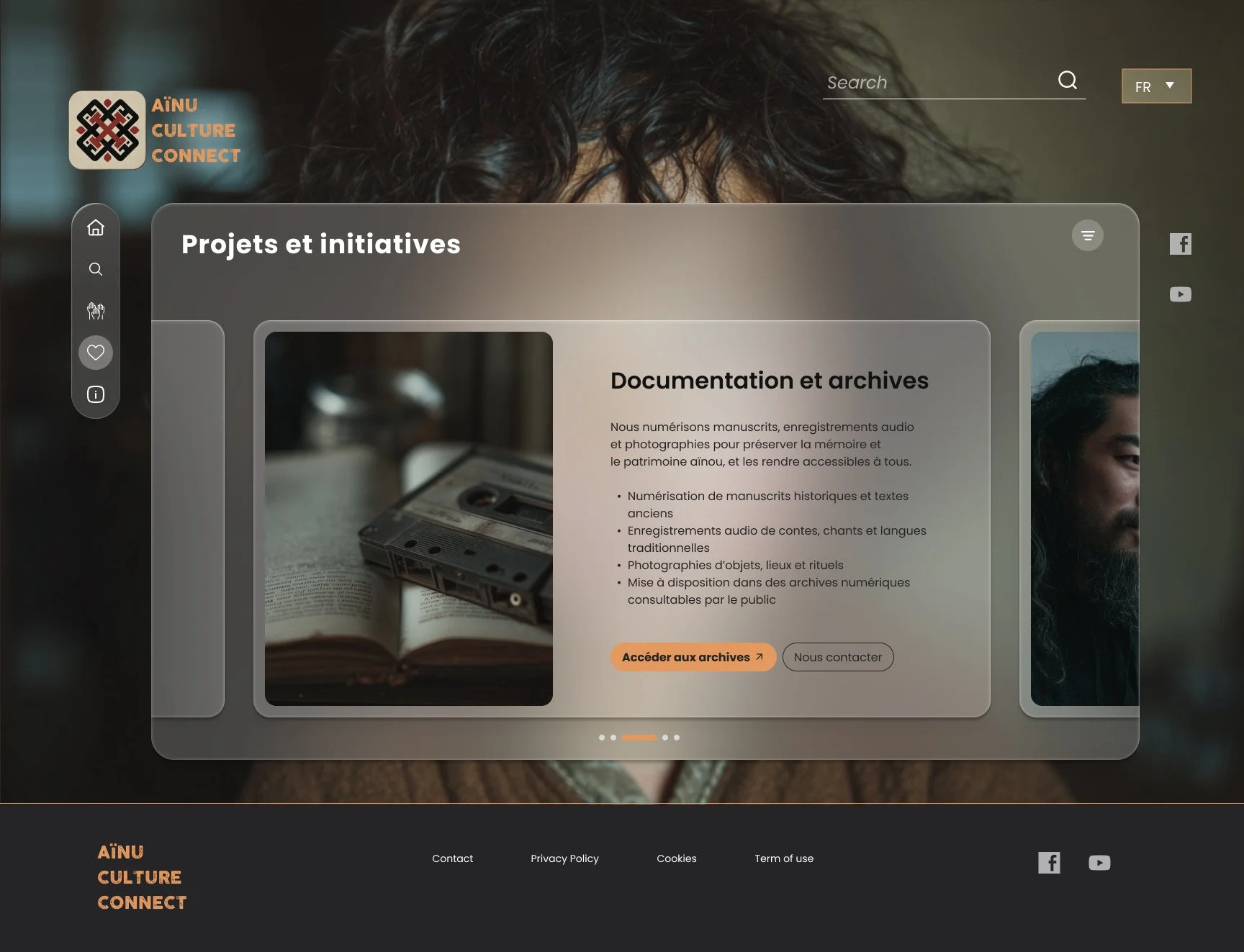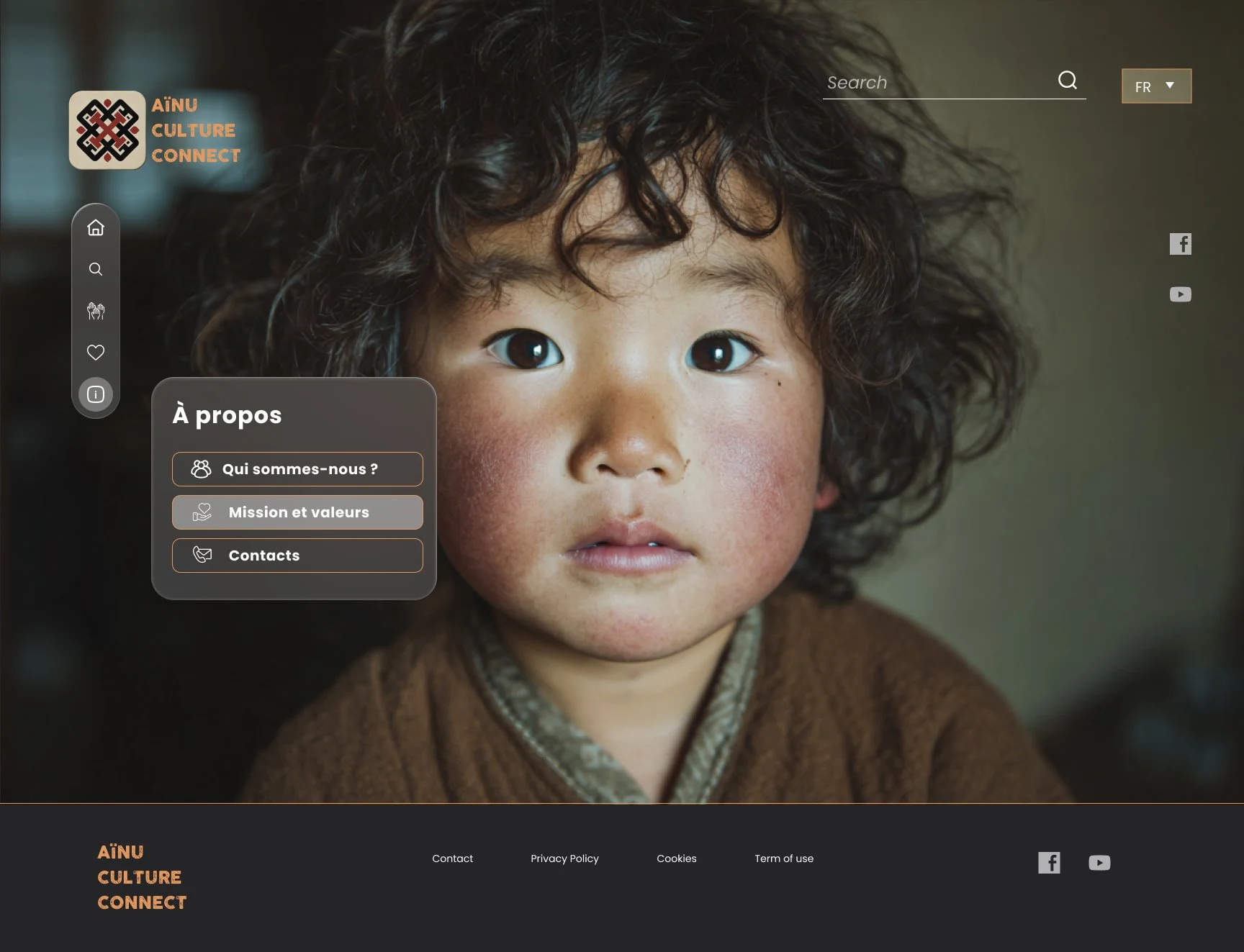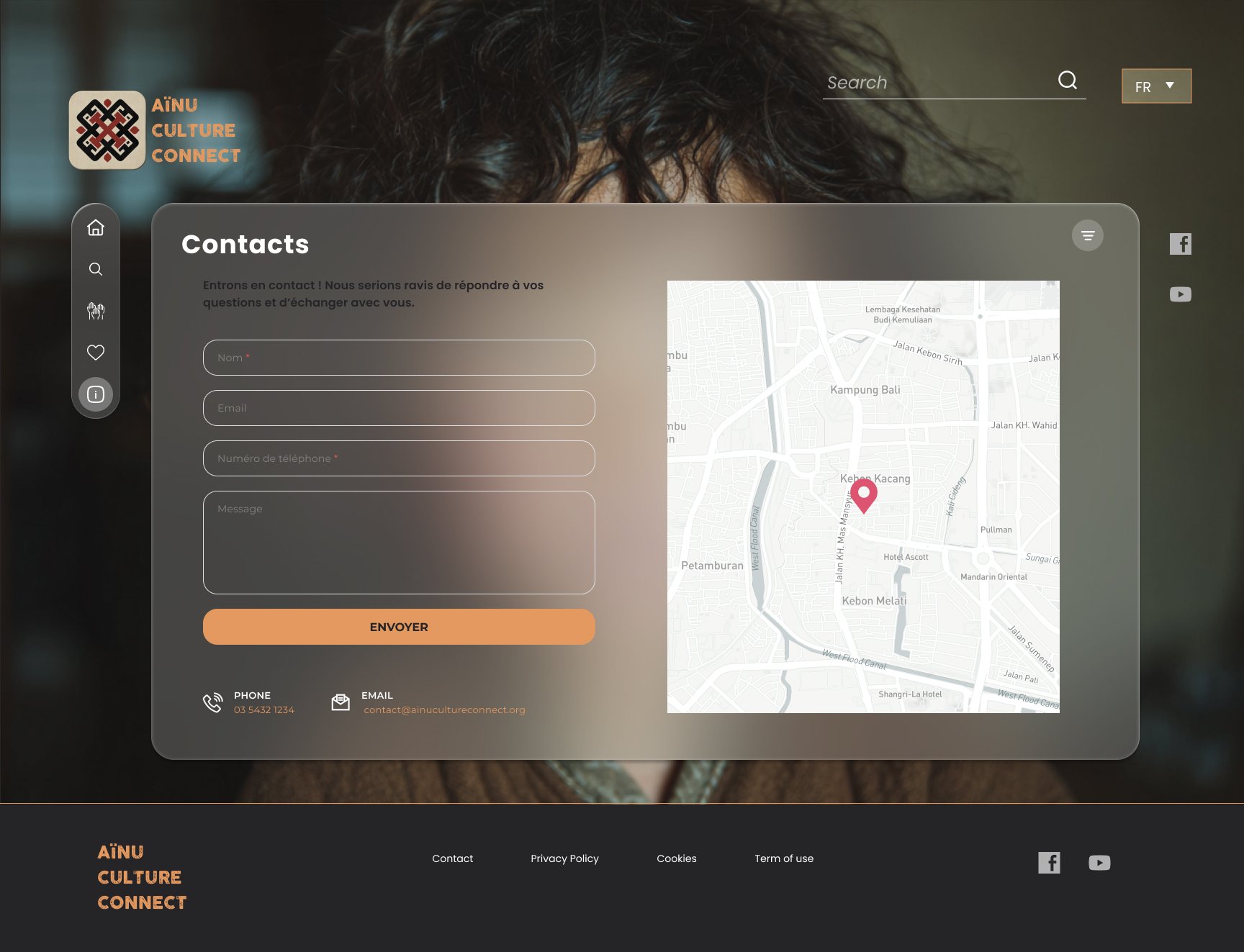Ainu Culture Connect
Connecting users to Ainu culture
A platform designed for culture enthusiasts and curators
Overview
ROLE
Product Design (UX/UI)
Tools used :
Figma / Midjourney / Photoshop
Duration :
4 weeks
Story
Satoshi is an ethnology student who wants to explore Ainu culture for his research.
Every week, he spent hours searching for archives, consulting scattered articles, and looking up cultural events.
He wanted a solution that was centralized, immersive, and respectful of the tradition.
That’s how Ainu Culture Connect was born : a website that allows users to discover, participate, and support Ainu culture easily, while telling its stories.
The Problem
Dispersed and fragmented information
Satoshi had to navigate multiple websites, archives, and publications to find reliable resources.
Difficulty engaging with initiatives
Events and projects were poorly centralized, making participation complicated.Lack of narrative context
Available content was often technical, not immersive, and failed to convey the emotion or history behind the culture.
Result : wasted time, frustration, and limited engagement despite genuine interest.
Our Solution : Ainu Culture Connect
Discover
Articles, digitized archives, photographs, and audio, each piece of content is presented as an immersive story, contextualized to convey emotion and tradition.Participate
Event calendar, interactive workshops, and volunteer opportunities. Each event is framed as a living invitation to join the community.Support
Highlighting preservation projects and local artisans, with mini-profiles of cultural actors and the tangible impact of contributions.
01 / Empathize - Exploring the user's needs
Overview
Research approach
Competitive analysis
Research Approach
To deeply understand the needs and expectations of potential users for Ainu Culture Connect, I employed two primary research methods: competitive analysis and user interviews. For the competitive analysis, I examined both direct and indirect competitors, focusing on how cultural preservation is represented online. Additionally, I researched current trends and challenges in cultural heritage websites to identify opportunities for improvement.
The goals for my research process were the following :
Uncover design patterns that users are familiar with on similar cultural and heritage websites.
Identify pain points and unmet needs when exploring and learning about Ainu culture online.
Understand the motivations and desires of users who are passionate about cultural preservation and education.
Competitive Analysis
To gain a deeper understanding of the cultural preservation market and user expectations, I conducted a competitive analysis, examining both direct and indirect competitors in the heritage and cultural education space. This analysis helped to uncover existing design patterns, highlight industry trends, and identify common obstacles faced by similar websites.
03 / Ideate - Creating the framework
Overview
Sitemap
For the Ainu Culture Connect website, the sitemap was designed to offer a fluid and intuitive user experience, focused on the discovery and preservation of Ainu culture. The user flow begins with an engaging homepage that showcases the main content and sections of the site.
Users can directly access key sections : information on Ainu culture, traditions, educational resources, and upcoming events. The site also offers search and filter features to easily find articles, exhibitions and workshops. A dedicated section allows visitors to discover and contribute to current projects, while facilitating access to tools for making donations or supporting the organization.
The design takes accessibility and responsiveness into account, ensuring the site is usable on various devices. The plan aims to offer smooth navigation, an enriching discovery of cultural content, and active participation from the community.
Persona development 01
John Miller, 45, is a cultural anthropology researcher and avid traveler based in London. With a focus on indigenous cultures, John frequently turns to website for in-depth articles, research reports, and detailed case studies on Ainu culture. As a meticulous academic, John values a platform for its reliable, comprehensive resources, which are crucial for his publications. Despite his frequent travels, he consistently relies on the site to gather accurate and relevant information before and after his fieldwork, ensuring his research is well-informed and thorough.
Persona development 02
The Tanaka family, originally from Kyoto, uses a mobile app to explore Ainu recipes and follow cultural events in real time. The father, a cooking enthusiast, and the mother, interested in artisanal traditions, want to integrate elements of Ainu culture into their family activities. Children, curious and enthusiastic, take advantage of the application to discover cultural events adapted to their age. At the same time, they turn to a website for art tutorials and in-depth articles on Ainu culture, allowing them to supplement their knowledge with in-depth resources. This approach provides them with an enriching experience by combining hands-on learning and in-depth cultural content in their family projects.
Problems
How might we simplify the navigation for users seeking easy access to culture and events ?
How might we ensure the website provide engaging and detailed cultural content to enhance user learning ?
How might we streamline the process for users to share their experiences and contribute to the community ?
How might we improve accessibility and usability for users with varying levels of tech familiarity and language preferences?
04 / Prototype - Bringing the vision to life !
Wireframes and low fidelity prototype
For the digital wireframes of Ainu Culture Connect, our goals were to create intuitive and visually appealing interfaces that facilitate access to Ainu culture. We first established wireframes focusing on information hierarchy and smooth navigation, taking into account user needs. When reviewing the wireframes, we asked for feedback. The observations highlighted the need to improve certain navigation areas and adjust the layout for better accessibility. We incorporated these suggestions by refining interactions and simplifying user journeys, thus ensuring a more coherent and functional experience.
Low Fidelity Prototype Usability Test
I tested the high-fidelity prototype with 5 participants to identify key issues and areas of confusion. These insights guided improvements in the final design. Here are some of the findings I used to improve my design for the high fidelity prototype :
Navigation and access to content : Users had difficulty accessing information on Ainu culture. Simplified and more intuitive navigation would improve the user experience by facilitating access to the content sought.
Engagement with Cultural Content : User interest in cultural explanations revealed an opportunity for engagement. Highlighting the cultural contexts and histories of Ainu traditions could enrich the experience and encourage users to explore the site further.
Technical Problems : Broken links caused frustration. Fixing technical issues would help maintain a smooth and pleasant user experience.
02 / Define - Establishing the user's needs and problems
Overview
Persona development
Final Design
(after tests)
Development of the digital library : Create and integrate the online digital library, providing access to cultural resources, articles, and documents on Ainu culture.
Continuous optimization and testing : Conduct regular performance and accessibility testing to ensure a smooth user experience and identify areas requiring improvement or adjustments.
Reflections & Take-aways
Impact :
The designs for Ainu Culture Connect had a significant impact on user engagement, as evidenced by positive feedback from participants. One user noted: "The site is smooth to navigate and make exploring Ainu culture easy."
What I learned :
Through this project, I really understood the importance of listening to users and testing our ideas in a real situation. The feedback helped me see how even small changes can greatly improve the experience. Working on this site taught me how to better anticipate user needs and refine designs to be more intuitive and engaging.
Next steps
05 / Test - Time to test !
Overview
Usability Test Plan
Usability Test Objectives
Usability Test Findings
Next Steps
Usability Test Plan
I recruited 7 participants for the Usability Test.
Usability Test Objectives
Evaluate effectiveness, efficiency, and user satisfaction when interacting with the high-fidelity prototype.
Usability Test Findings
Participants were able to complete the tasks, but initial tests revealed that the site contained too many large images, excessive text, and lacked visual appeal and intuitive flow, which could overwhelm users. The prototypes were then simplified and harmonized, with a cleaner layout, better balance of visuals and text, and a more intuitive navigation. Despite these adjustments, testers still found the site very comprehensive, and the overall experience remains fluid, engaging, and authentic, effectively showcasing the richness of Ainu culture.























